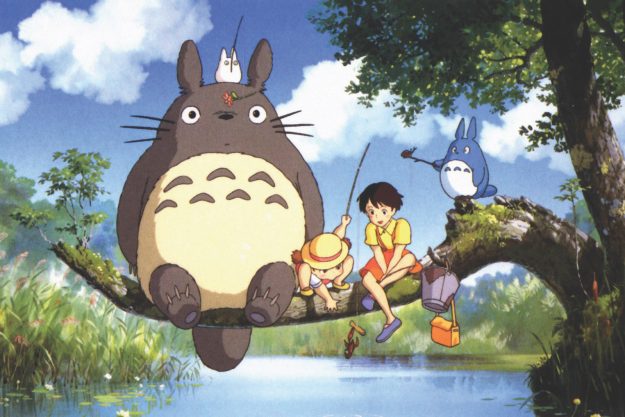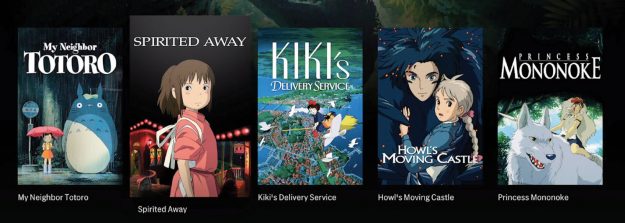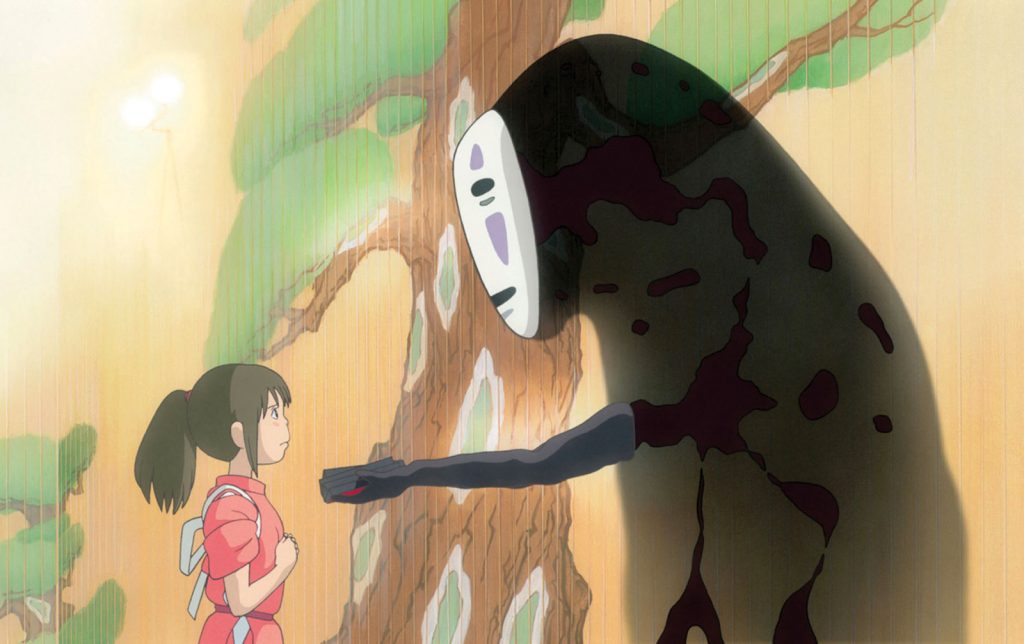Two young girls are caught in a sudden rainstorm. They dash toward the only shelter they can find: a small roadside shrine dedicated to the bodhisattva Jizo. The older girl respectfully apologizes for their intrusion: “Mr. Jizo, please let us wait out the rain for a little while.” She and her sister briefly bow their heads in front of the statue, hands clasped reverently before them.
Some readers may recognize this scene from Hayao Miyazaki’s animated film My Neighbor Totoro (1988), now available to subscribers of HBO’s Max streaming service along with 20 other films from Studio Ghibli, the famed Japanese animation studio helmed by the directors Miyazaki, Toshio Suzuki, and the late Isao Takahata. Collectively, these directors have produced some of the most memorable animated films of the last four decades, including the Academy Award-winning Spirited Away (2001).
Audiences and critics have long marveled at the alchemy of gorgeous hand-drawn animation and captivating storytelling behind Studio Ghibli’s global box-office success. Notably, many professional observers have commented on the tendency of Ghibli films to feature “spiritual” content. We often read, for example, that Ghibli’s films reconnect contemporary Japanese audiences with their religious heritage. This alluring interpretation is accurate to an extent, but it is also misleading. Studio Ghibli director Isao Takahata was quite deliberate in using the anime medium to introduce young audiences to themes he drew from premodern Buddhist literature. His 1994 film Pom Poko, about a group of mythical tanuki (Japanese raccoon dogs) whose forest dwelling is threatened by suburban expansion, reproduced images from Buddhist devotional art and illustrated picture scrolls. His elegiac 2013 film The Tale of the Princess Kaguya is based on the 9th-century “Tale of the Bamboo Cutter” and reprises the story’s central theme, the Buddhist notion of impermanence.

If Takahata’s reliance on religious iconography was fairly obvious, Hayao Miyazaki’s films have been much more ambiguous. To return to the rainy scene from My Neighbor Totoro, at first glance it seems that Miyazaki was modeling proper Buddhist behavior, showing young viewers how to properly pay respects to a widely venerated Buddhist deity. As tempting as this reading may be, however, it misses a crucial point. In Totoro and his other films, Miyazaki uses the institutional religions of Buddhism and Shinto as foils for a deeper, if latent, relationship between humans, nature, and spirits. In Totoro, for example, Miyazaki’s depiction of the Jizo statues, as well as fox statues associated with the Shinto deity Inari, are cold and lifeless. These artificial icons stand in stark contrast to the titular character of Totoro, a vibrant and lovable spirit who inhabits an enormous camphor tree that dominates the neighborhood where the film is set. In interviews as well, Miyazaki has repeatedly stated his distaste for organized religion, indicating instead his preference for a romanticized spirituality associated with an ancient “forest civilization.” As one character in Totoro announces, “Long ago, trees and humans used to be close friends.”
To say that Miyazaki’s films downplay institutional religion and eschew formal doctrine is not to say that his films lack inspiring or profound lessons for their audiences. Through in-person interviews and internet-based ethnography that I conducted between 2005 and 2010, I found that many Miyazaki fans saw his films as holding valuable life lessons and viewed his protagonists as role models to emulate. Some fans even made pilgrimages to real-world places that purportedly served as the settings for Ghibli stories. Fans of Princess Mononoke (1997) have traveled to the remote island of Yakushima, the supposed inspiration for the film’s ancient forest, in search of the kodama (tree spirits) memorably depicted by Miyazaki as elusive white figures that emit a peculiar clicking sound. And mapping Studio Ghibli’s enchanting animated forests onto real-world locales is not limited to Japan: while on a hike in the redwoods outside of Arcata, California, in May 2015, I saw that a local artist had stenciled images of Ghibli-style kodama on several trail markers.

There are many persuasive explanations for why Studio Ghibli has enjoyed so much cultural influence, but to my mind one of the defining features of the films is their stubborn refusal to paint a morally monochromatic world. The stories are almost never about “good guys” versus “bad guys.” Most feature conflicts between competing factions, nearly all of whom reveal themselves to be relatable, sympathetic characters with understandable (if sometimes misguided) motivations. The people who initially appear as antagonists often turn out to have been wronged themselves. They may threaten the protagonists, but often it is their own struggle for survival that leads them to desperate and dangerous actions.
This recurring theme of reconciliation and renewal, rather than the notion of reconnecting with religious heritage, can better (though still only roughly) characterize the sprawling Ghibli oeuvre. In Miyazaki’s Nausicaä of the Valley of the Wind (1984), for instance, Princess Nausicaä struggles valiantly to reconcile the warring factions of her postapocalyptic society; she also vainly attempts to convince her fellow humans that the ecological processes they see as threats to their own well-being are nature’s attempt to heal itself. Similarly, in Takahata’s Pom Poko, the tanuki on the outskirts of Tokyo use their shapeshifting magic to fight against encroaching housing developments, but ultimately they work out a cautious coexistence with the very humans who threaten them. In Princess Mononoke, humans destroy the sacred abode of the Great Forest Spirit, a violation that demands retribution, but retribution also brings recognition. As one astonished character exclaims at the close of the film: “I never knew it was the Great Forest Spirit who made the flowers grow!”
Amid a global pandemic, climate change-driven hazards, and national uprisings protesting police brutality, perhaps we all could use a dose of Ghibli-style reconciliation and renewal. Studio Ghibli’s films may not hold religious lessons as such, but they do show that the world is always tinged with a hint of sadness, that everyone could use a little kindness, and that each of us has a responsibility to make things right.
Thank you for subscribing to Tricycle! As a nonprofit, we depend on readers like you to keep Buddhist teachings and practices widely available.
